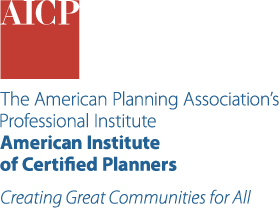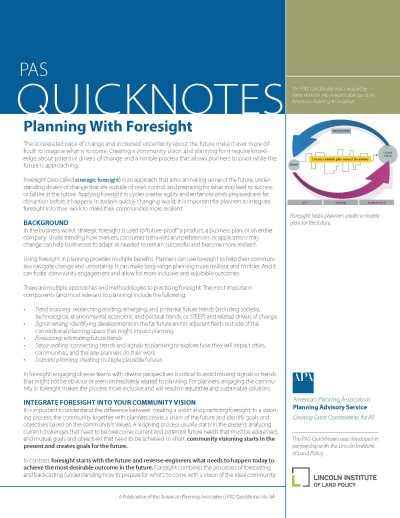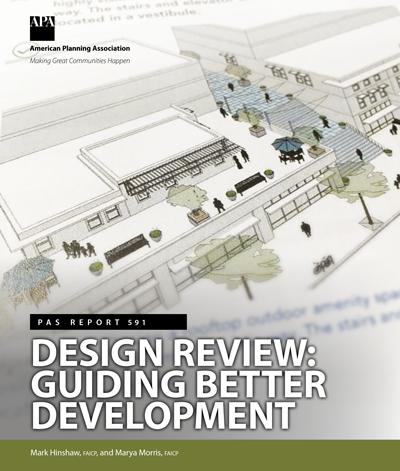Looking for education on this topic?
Check Out Our Passport Courses
Passport is your ticket to the training, experiences, and connections that will take you where you want to go in your planning career. Subscribe for unlimited access for one year to APA's extensive learning library of solution-oriented content facilitated by planners, for planners.
-
Will We Zone For Transit?
by: Grant Holub-MoormanUncovering JAPA: Explore how transit-oriented development (TOD) emerged as a crucial strategy in curbing urban sprawl with the 2023 Montreal light rail project. -
2022 Trend Report for Planners
by: Petra Hurtado, PhD, Sagar Shah, PhD, , Joseph DeAngelis, AICP, Alexsandra Gomez January 18, 2022The 2022 Trend Report for Planners features nearly 100 existing, emerging, and potential future trends that APA identified as relevant to planning. The trends are structured within three timeframes (Act Now, Prepare, Learn and Watch), which indicate the urgency of planners’ action. -
Climate-Resilient Pollinator Gardens
PAS QuickNotes 96by: Sagar Shah, PhD, AICPThis edition of PAS QuickNotes explains how planners can use pollinator gardens with native plants to enhance their communities, increase climate resiliency by reducing extreme heat and flooding risks, and achieve the GI goals of protecting natural ecosystems and conserving biodiversity.Nonmember price$0.00APA members & PAS subscribers$0.00 -
Urban Heat Resilience
PAS QuickNotes 95by: Ladd Keith, Sara MeerowThis edition of PAS QuickNotes explains national trends in extreme heat and describes how planners can enhance urban heat resilience for their communities through planning and implementing heat mitigation and management strategies.Nonmember price$10.00APA members & PAS subscribers$0.00 -
Smarter Zoning by Street and by Block
Zoning Practice — August 2021by: John Myers August 01, 2021This issue of Zoning Practice proposes a new, ultralocal, approach to upzoning that would use resident-initiated upzonings to increase housing supply and diversity on a street-by-street or block-by-block basis.List price$10.00ZP subscriber$0.00 -
Planning Officials Training Program
Planning Officials are often appointed with little to no background in community planning. Once appointed, there generally is little time and limited resources to secure the training needed to help them make sound decisions for their communities. APA's Planning Officials Training Program gives planners the tools and resources to effectively and easily on-board and train planning officials.December 20, 2021, 12:00 a.m. to January 25, 2024, 12:00 a.m. CST- Linda Amato, FAICP
- Ann Bagley, FAICP
- Michael Blue, FAICP
- Bonnie Johnson, FAICP, PhD
- Gregory Jones, AICP
- Stan Popovich, AICP
- Marjorie Press
- David Silverman, FAICP
#9227447Planning for Autonomous Mobility
PAS Report 592by: Jeremy Crute, William Riggs, AICP, Timothy Chapin, Lindsay Stevens, AICP September 01, 2018Autonomous vehicles are poised to disrupt the built environment and planning practices. This PAS Report offers a road map for planners as they develop policy solutions and infrastructure investments for the future of AVs.List price$25.00APA member & PAS subscriber$0.00Guiding Plan Implementation With Degree of Change
PAS Memo — July-August 2021by: John Zeanah, AICPThis edition of PAS Memo explores how the city of Memphis used the Degree of Change approach to guide plan implementation and community reinvestment by targeting appropriate actions to designated Accelerate, Sustain, and Nurture areas of the city.Nonmember price$10.00APA members & PAS subscribers$0.00Planning With Foresight
PAS QuickNotes 94by: Petra Hurtado, PhDThis edition of PAS QuickNotes introduces the concept of foresight to help planners imagine and prepare their communities for the future.Nonmember price$0.00APA members & PAS subscribers$0.00Design Review: Guiding Better Development
PAS Report 591by: Mark Hinshaw, FAICP, Marya Morris, FAICP July 01, 2018Get an update on the time-tested tool of design review and guidance on creating effective design review processes, standards, and guidelines to improve development in local communities.List price$25.00APA member & PAS subscriber$0.00Illinois Solar Model Ordinance
August 2020This model ordinance provides a template to help planners in Illinois draft land-use and development regulations that permit solar development at different scales and in different land-use contexts.Iowa Solar Model Ordinance
August 2020This model ordinance provides a template to help planners in Iowa draft land-use and development regulations that permit solar development at different scales and in different land-use contexts.Wisconsin Solar Model Ordinance
August 2020This model ordinance provides a template to help planners in Wisconsin draft land-use and development regulations that permit solar development at different scales and in different land-use contexts.Minnesota Solar Model Ordinance
August 2020This model ordinance provides a template to help planners in Minnesota draft land-use and development regulations that permit solar development at different scales and in different land-use contexts.Kentucky Model Solar Zoning Ordinance
September 2020This model ordinance provides a template to help planners in Kentucky draft land-use and development regulations that permit solar development at different scales and in different land-use contexts.Model Site Plan Regulations and Conditional Use Permits to Support Solar Energy Systems in Maine Municipalities
February 2020This model ordinance provides a template to help planners in Maine draft land-use and development regulations that permit solar development at different scales and in different land-use contexts.Siting Utility-Scale Solar and Wind in Iowa: A Guide for Local Governments
April 2020by: Jenna Greene, Brian Ross, AICP, Jessica WyattThis guide is designed to help local government staff and officials understand the market potential of and opportunities to support large-scale wind and solar development.Solar Energy: SolSmart's Toolkit for Local Governments
2020This guide is designed to help local government staff and officials identify and take advantage of opportunities to grow local solar markets.State Pollinator-Friendly Solar Initiatives
January 2020by: Georgena TerryThis briefing paper is designed to help state officials and policy advocates understand existing state policies and initiatives aimed at protecting or expanding pollinator habitat through solar development.Anatomy of Brownfields Redevelopment
June 2019This briefing paper provides a high-level overview of brownfields redevelopment issues.An Opportunity for Maryland to Get Solar Siting Right
Abell Report Volume 32, Number 7, September 2019by: Dru Schmidt-PerkinsThis report is designed to help state officials and policy advocates in Maryland understand opportunities to encourage solar development after the passage of the Clean Energy Jobs Act.Lake County, IL, Solar Energy Task Force Model Ordinance
2019This model ordinance provides a template to help municipal planners in Lake County, Illinois, draft land-use and development regulations that permit solar development at different scales and in different land-use contexts.York County, PA, Solar Energy Systems Model Ordinance
2018This model ordinance provides a template to help municipal planners in York County, Pennsylvania, draft land-use and development regulations that permit solar development at different scales and in different contexts.York County, SC, Code of Ordinances
Updated January 2020The county's zoning code permits solar energy systems as a principal use in agricultural zoning districtsRecommendations for Utility-Scale Solar Developers: Best Practices for Land Use and Zoning Project Approval
March 2018by: Maggie ClarkThis briefing paper is designed to help solar developers in North Carolina and Virginia plan and implement large-scale solar projects.Community Actions that Drive Brownfields Redevelopment
June 2019This guide is designed to help communities plan and implement successful brownfield redevelopment projects.Climate Smart Brownfields Manual
December 2016This guide is designed to help communities plan and implement brownfields redevelopment projects that promote climate resilience.Air and Water Quality Impacts of Brownfields Redevelopment
April 2011This report compares five brownfield and infill development projects to comparable greenfield development projects.Brownfields Financing Resource Center
Updated 2020This clearinghouse provides information on state, local, and national brownfield funding programs.Brownfield Revitalization in Climate-Vulnerable Areas
January 2016This USEPA report offers insights into the unique challenges and opportunities of brownfield redevelopment in climate-vulnerable areas.Beyond Natural and Economic Impacts: A Model for Social Impact Assessment of Brownfields Development Programs and a Case Study of Northeast Wilmington, Delaware
April 2011This report applies a model of brownfield redevelopment the authors refer to as a social impact assessment (SIA).Building Vibrant Communities: Community Benefits of Land Revitalization
October 2009This report reviews brownfield projects from across the country.Financing Mechanisms for Addressing Remediation of Site Contamination
October 2014This report was commissioned by the World Bank to examine financing options for brownfield redevelopment projects.Recycling America’s Land: A National Report on Brownfields Redevelopment
May 2006This report provides results from a national survey of cities on their experiences with brownfields redevelopment.Connecting Smart Growth and Brownfields Redevelopment
November 2006This report contextualizes brownfields redevelopment against the backdrop of wider “smart growth” policies.Cleaning Up Brownfields Under State Response Programs – Getting to “No Further Action”
August 2016This report summarizes state responses to brownfields redevelopment.Unlocking Brownfields: Keys to Community Revitalization
2005by: Matt Ward, Charlie Bartsch, Ken BrownThis report charts progress on brownfield redevelopment at the national level.The Environmental and Economic Impact of Brownfield Redevelopment
July 2008by: Evans Paull, AICPThis report examines the quantifiable effects of brownfields redevelopment.The Value of Brownfield Remediation
July 2014by: Kevin Haninger, Lala Ma, Christopher TimminsThis report estimates the value of brownfield remediation projects.Tribal Brownfields and Response Programs Respecting Our Land, Revitalizing Our Communities
December 2014This report explores brownfield redevelopment in tribal communities.Implementing Stormwater Infiltration Practices at Vacant Parcels and Brownfield Sites
July 2013This briefing paper examines brownfields redevelopment and groundwater infiltration.Community Transformation Through Brownfields Redevelopment
2017This briefing paper examines the positive effects of brownfield redevelopment on communities.Proposal to Remove Barriers to Local Governments Addressing Mothballed Brownfield Sites
2012This briefing paper outlines a variety of laws and regulations that encourage or discourage brownfields redevelopment.Sustainable Water Management on Brownfield Sites
October 2012by: Ryan FenwickThis short guide provides information on green stormwater infrastructure development on brownfield sites.Redeveloping Brownfield Sites
2012This briefing paper contains guidance on planning for brownfield redevelopment.Unlocking Brownfields Redevelopment: Establishing a Local Revolving Loan Fund Program
August 2008This briefing paper outlines how community leaders can create a local revolving loan fund for brownfields redevelopment.A Citizen's Guide to Phytoremediation
September 2012This fact sheet is a two-page guide to phytoremediation.Environmental Contaminants Often Found at Brownfield Sites
September 2019This fact sheet explains a variety of the most common contaminants of brownfield sites, outlining common origins and potential health risks.Assessing Brownfield Sites
June 2020This fact sheet examines the common steps of identifying and assessing brownfields.RE-Powering America’s Land Potential Advantages of Reusing Potentially Contaminated Land for Renewable Energy
July 2012This fact sheet highlights the benefits of using potentially contaminated land (brownfields, superfund sites, etc.) for renewable energy development.









